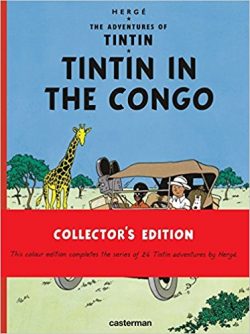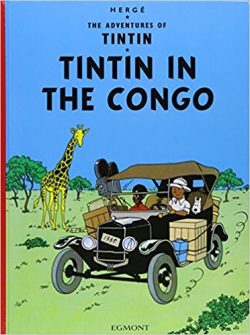

By Hergé & various; translated by Leslie Lonsdale-Cooper and Michael Turner (Egmont)
ISBN: 978-2-20309-650-9 (2016 HB)Â Â Â Â Â Â Â Â Â Â :978-0-78595-830-7 (1987 HB)
:978-1-40526-651-2 (PB)
Georges Prosper Remi, known universally as Hergé, created a true masterpiece of graphic literature with his many tales of a plucky boy reporter and his entourage of iconic associates.
Singly, and later with assistants including Edgar P. Jacobs, Bob de Moor and the Hergé Studio, Remi completed 23 splendid volumes (originally produced in brief instalments for a variety of periodicals) that have grown beyond their popular culture roots and attained the status of High Art.
Like Charles Dickens with the Mystery of Edwin Drood, Herg̩ died in the throes of creation, and final outing Tintin and Alph-Art remains a volume without a conclusion, but still a fascinating examination Рand a pictorial memorial of how the artist worked.
It’s only fair though, to ascribe a substantial proportion of credit to the many translators whose diligent contributions have enabled the series to be understood and beloved in 38 languages. The subtle, canny, witty and slyly funny English versions are the work of Leslie Lonsdale-Cooper & Michael Turner.
On leaving school in 1925, Remi worked for Catholic newspaper Le XXe Siécle where he seems to have fallen under the influence of its Svengali-like editor Abbot Norbert Wallez. The following year, the young artist – himself a dedicated boy-scout – produced his first strip series – The Adventures of Totor – for the monthly Boy Scouts of Belgium magazine and by 1928 was in charge of producing the contents of Le XXe Siécle’s children’s weekly supplement Le Petit Vingtiéme.
He was unhappily illustrating The Adventures of Flup, Nénesse, Poussette and Cochonette (written by the staff sports reporter) when Abbot Wallez urged Remi to create a new adventure series. Perhaps a young reporter who would travel the world, doing good whilst displaying solid Catholic values and virtues?
And also, perhaps, highlight and expose some the Faith’s greatest enemies and threats…?
Having recently discovered the word balloon in imported newspaper strips, Remi decided to incorporate this simple yet effective innovation into his own work. He would produce a strip that was modern and action-packed. Beginning on January 10th 1929, Tintin in the Land of the Soviets appeared in weekly instalments in Le Petit Vingtiéme, eventually running until May 8th 1930. The boy-hero – a combination of Ideal Good Scout and Remi’s own brother Paul (a soldier in the Belgian Army) would be accompanied by his dog Milou (Snowy to us Brits) and report back all the inequities from the “Godless Russiasâ€.
The strip’s prime conceit was that Tintin was an actual foreign correspondent for Le Petit Vingtiéme…
The odyssey was a huge success, assuring further – albeit less politically charged and controversial exploits – to follow. At least that was the plan…
Whereas the originally serialised tale was simply black and white and episodic, Tintin in the Congo as a book is much more stylistically familiar to modern readers. This saga, which originally ran in Le Petit Vingtiéme from June 1930 to June 1931, was radically restructured in 1946 for release as a collected album, and later, a rather shocking page featuring a rhinoceros, a hand-drill and a stick of dynamite was deftly replaced with a much funnier scene…
Moreover, this tale was unavailable to English-readers for years due to its depiction of ethic people and its white Eurocentric bias: a situation confronted and addressed head-on in the 2016 Collectors Edition in a forthright and contextualising Forward…
So, making allowances for the time frame, what’s here?
Still hampered by his weekly, episodic format, Tintin and Snowy take ship for the Belgian Congo where they perforce have many little adventures, but also incredibly uncover a plot by US gangster Al Capone to take control of Africa’s diamond trade…
The book version features a Tintin retrofitted for both artistic and commercial reasons. By 1946 Hergé had completed thirteen full Tintin adventures and the characters were fully developed. It was both logical and preferable that new readers be presented with a consistent vision. Moreover, as Hergé had grown as both author and artist, the album editions gave him an opportunity to rectify some earlier decisions that he had long regretted.
When producing work for a perpetual deadline not only are you trapped by the urgent need to finish and move on, but you are imprisoned in the context of your own times. When ‘The Congo’ ran in 1930-1931, representations of ethnicities and more importantly the attitudes of a Belgium that was still a Colonial and Imperial Power informed the text and indubitably influenced the Catholic newspaper then paying for the strip.
In later years Hergé admitted to deeply regretting much of his early work and took every opportunity to repair it.
A scene in which natives are taught that they are happy Belgians was gladly replaced with a maths lesson and many images and scenes were subtly altered to enhance the standing and image of native Africans. The ongoing controversy regarding ethnic depictions in historical comics (and remember, this tale is almost ninety years old) seems doubly cynical and politically self-serving when one considers that Hergé was rectifying what he saw as racial slurs in the 1940s whilst modern society is still denying that there’s a problem. For every black African waving a spear and shield in this story there’s another in a suit, a uniform or tee shirt.
This yarn might be potentially controversial but it is also the transitional outing that confirmed the boy-hero’s drawing power: a highly readable, joyously thrilling, exuberant and deeply informative adventure romp for any fan of the comic strip medium.
And, although each exploit can be read singly, since Hergé was an early proponent of extended continuity, this early epic is actually necessary reading if you want a better understanding of the Tintin masterpieces to come.
Tintin in the Congo: artwork © 1946, 1974, 2016 Editions Casterman, Paris & Tournai.
Text © 2005 Egmont UK Limited. All Rights Reserved.
